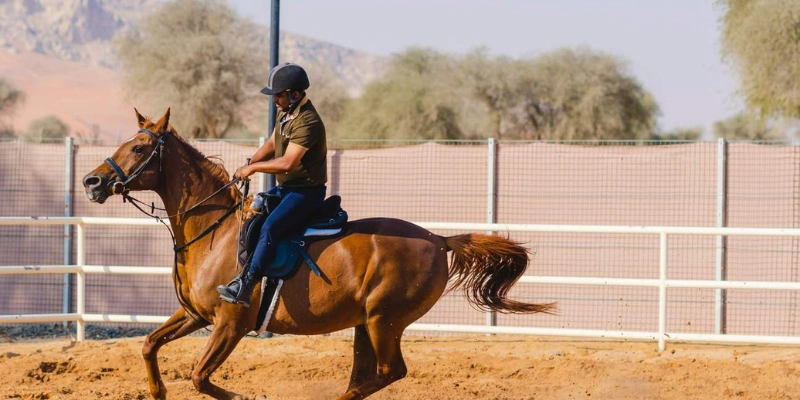Why Horse Riding Etiquette Matters
Horse riding is not just a sport—it’s a relationship between rider, horse, and often a wider equestrian community. Behind the graceful strides and thrilling rides lies a quiet system of behavior that ensures safety, trust, and harmony. This system is known as horse riding etiquette.
Good etiquette isn’t only about looking polished; it’s about being mindful of your horse, of other riders, and of the shared environment. Whether you’re a weekend trail rider or training for competitions, knowing and practicing proper riding rules is essential. The smallest courtesies can transform your riding experience—from chaos to calm, from stress to satisfaction.
1. Your First Impression: How You Approach the Horse Matters
Before you even touch a rein, your horse is reading your body language. Horses are intuitive animals, sensitive to energy and tone. How you approach a horse sets the tone for your entire ride.
What to do:
- Approach slowly from the side where the horse can see you.
- Use calm, low tones to greet your horse.
- Always make your presence known—never surprise a horse.
What not to do:
- Never run or shout near a horse.
- Avoid standing directly behind a horse.
- Don’t pet or handle another rider’s horse without permission.
- These simple horseback riding tips lay the foundation of mutual respect and trust.
2. Mounting Up with Mindfulness
Mounting your horse is more than a routine—it’s an act of trust. It’s important to ensure both you and your horse are ready before swinging into the saddle.
Riding rules for mounting:
- Mount from the horse’s left side unless otherwise instructed.
- Use a mounting block when possible to reduce strain on the horse.
- Make sure your girth or cinch is tight and stirrups are adjusted.
Avoid:
- Mounting too close to other horses.
- Pulling on the reins while mounting.
- Rushing—haste leads to mistakes.
- This stage sets the rhythm for your horse riding session, so take your time and do it right.
3. Mastering the Arena Code
The riding arena is a shared space, and just like a busy road, it has its flow. Ignoring this flow can cause confusion or accidents.
Essential arena etiquette:
- Always pass left shoulder to left shoulder when riding in opposite directions.
- Slower riders should keep to the inside track.
- Announce when passing: “On your right!” or “Outside!”
What to avoid:
- Stopping suddenly without warning.
- Cutting across diagonals without checking traffic.
- Distracting other riders with loud conversations or gestures.
- Following these horse riding etiquette practices helps maintain order and keeps both horse and human safe.
4. Sharing the Trail with Grace
Trail riding brings a sense of freedom, but it still requires discipline. You’re not just sharing space with fellow riders but also with nature lovers, hikers, and sometimes wildlife.
Trail riding tips:
- Ride single-file on narrow paths.
- Keep a steady pace and don’t tailgate other horses.
- Yield to hikers and bikers when necessary.
Bad habits to leave behind:
- Letting your horse stop to graze without warning.
- Breaking into a trot or canter unexpectedly in a group.
- Leaving behind trash or disturbing natural surroundings.
- Trail riding is about enjoying the outdoors, but with courtesy and control.
5. The Golden Rule: Clean Up After Yourself
Stables are community hubs, and like any shared space, they rely on everyone doing their part. Good stable manners are a non-negotiable part of horseback riding tips.
Best practices:
- Return grooming tools, buckets, and tack to their proper places.
- Sweep up hair, hay, or dirt after grooming your horse.
- Check your horse’s stall or paddock for cleanliness.
Avoid:
- Leaving your gear lying around.
- Using others’ supplies without asking.
- Ignoring signs of discomfort or injury in your horse post-ride.
- Remember, your behavior in the stable reflects your character as a rider just as much as your performance in the saddle.
6. Polite Riders Make for Pleasant Rides
Riding is as much a social activity as it is an athletic one. Whether you’re in a lesson or a trail group, your communication style matters.
Communication etiquette includes:
- Listening to your trainer or guide without interrupting.
- Letting fellow riders know your horse’s quirks or sensitivities.
- Thanking those who help you—grooms, instructors, even fellow riders.
To avoid:
- Gossiping or criticizing other riders.
- Acting superior because of experience or skill.
- Ignoring safety reminders because “you know better.”
- The best horse riding environments are built on teamwork and mutual respect, not competition.
7. Know When to Step Back
Every rider wants to improve, and every horse wants to do their best—but pushing too far, too fast benefits no one.
Good judgment means:
Recognizing your horse’s mood and physical condition.
Accepting when you’ve reached your limit for the day.
- Postponing advanced activities until you’re properly trained.
Common missteps:
- Trying new techniques without supervision.
- Pushing a nervous or tired horse.
- Ignoring pain, injury, or misbehavior signs.
Practicing patience is a cornerstone of horse riding etiquette and a true mark of an experienced equestrian.
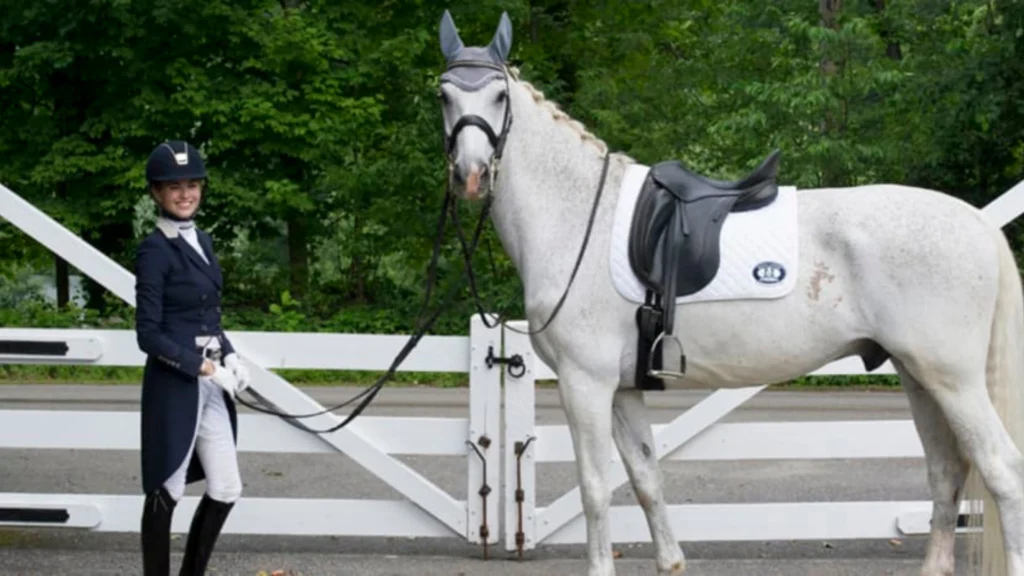
Pre-Ride Etiquette Every Rider Should Know
When it comes to horseback riding, success in the saddle begins long before your boots hit the stirrups. It starts with how you greet, handle, and groom your horse before the ride begins. Pre-ride behavior sets the tone not only for your interaction with the horse but also for your image in the stable community.
Inexperienced riders often underestimate the importance of simple manners at the barn. But experienced horsemen know that respecting the horse’s personal space, understanding its mood, and following stable etiquette are just as important as knowing how to ride.
Here’s a detailed look at pre-ride conduct, with a special focus on how good manners can make your horseback riding experience easier, safer, and more enjoyable.
Do: Greet the horse calmly and check its mood
Horses, like people, have different moods on different days. An important part of responsible horseback riding is recognizing how your horse is feeling before you saddle them.
Why it matters:
Horses are sensitive animals. They respond to energy, tone, and body language. A nervous or angry horse can react unpredictably, posing risks to both horse and rider. By taking a moment to connect, you build trust and cooperation.
Greetings before the ride that show respect:
- Approach the horse slowly from the side where it can see you.
- Use a gentle voice to say hello or call their name.
- Pay attention to cues: pinned ears, wagging tail, or wide eyes can indicate discomfort or irritation.
- Extend your hand for a sniff as a polite “introduction,” especially with horses you don’t know.
- This calm, respectful approach can prevent avoidable incidents and get your ride off to the right start.
Avoid approaching from behind or rushing the process.
A common mistake – especially among new riders – is to walk directly behind the horse or rush the grooming and tacking process. Both of these behaviors break basic horsemanship etiquette and can create dangerous situations.
Why approaching from behind is risky:
Horses have a blind spot directly behind them. Approaching this area quietly or suddenly can startle them and provoke kicking, often as a defensive reaction.
- Rushing the pre-ride process can lead to:
- Poorly fitted tack that can cause discomfort or injury
- Signs of illness, sores, or inflammation are overlooked.
- A tense or uncooperative horse during your ride
What to do instead:
- Always approach the horse from the front or side, speaking softly.
- Take your time with grooming – this is not just for cleaning but also to check and tack up your horse’s condition.
- Double-check all tack before boarding, making sure it is secure and comfortable.
- Respect the stable space: A shared responsibility.
- At any equestrian facility—whether it’s a private barn or a large training center—space is shared, and so are the responsibilities that come with it. Etiquette before a ride isn’t just about how you treat the horse; it also includes your behavior in the barn environment.
Tips for respecting the stable space:
- Keep your grooming kit, saddle, and gear organized and close to your designated area.
- Avoid blocking aisles or walkways with buckets, leads, or grooming tools.
- Clean up loose hair, hoof pieces, and other messes after grooming.
- Keeping the barn neat and organized isn’t just etiquette—it ensures the safety of both horses and humans.
- Always ask before touching another rider’s horse.
- This is one of the most overlooked but important rules in horseback riding etiquette. No matter how friendly or calm the horse may appear, it is never acceptable to touch, feed, or handle someone else’s horse without explicit permission.
Why is this rule in place?
- Horses may have sensitivities or medical issues that you don’t know about.
- Some horses are protective or reactive toward strangers.
- Owners may be working on specific training or routines that require consistency.
- Even small actions like giving the horse a treat or brushing its hair can confuse, break boundaries, or cause injury because of a bad reaction from the horse.
Good manners include:
- Ask the owner or handler before approaching the horse.
- Respect signs or warnings posted near the stall.
- Avoiding distractions when others are grooming the horse or preparing to ride.
- By following these unwritten rules, you show respect not only to the horse but also to your fellow riders.
Bonus Tip: Be Present and Patient
Horseback riding is not a rush job. It’s about rhythm, patience, and awareness. This mindset should be present from the moment you enter the barn.
Being present means:
Leaving distractions behind – putting your phone away.
- Paying full attention to your horse’s body language.
- Staying patient through grooming, tacking, and mounting, even if you’re in a hurry.
The horse can sense your energy, and a calm, focused rider builds confidence in the animal. If you want a smooth ride, start with a smooth mindset.
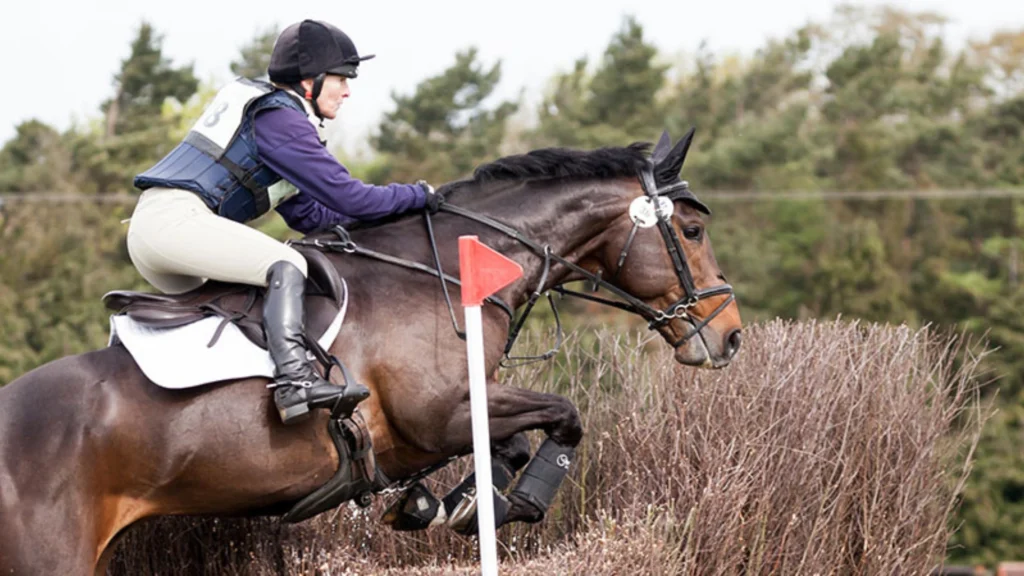
Mounting and Dismounting: Grace with Respect in Horse Riding
In the world of horse riding, how you begin and end your ride says a lot about you, not just as a rider, but as a horse person. Mounting and dismounting aren’t simply transitional moments; they are opportunities to demonstrate your care, control, and understanding of your equine partner.
Whether you’re at a busy arena, on a quiet trail, or in a riding lesson, these simple actions can either set the tone for a smooth ride or lead to unnecessary tension and risk. That’s why every rider should treat mounting and dismounting as important rituals, approached with both technique and thoughtfulness.
Let’s dive into the right (and wrong) ways to mount and dismount with grace and respect, core values of proper horse riding etiquette.
Do: Mount from the Left Unless Told Otherwise
Traditionally, riders mount a horse from the left side, also known as the “near side.” This custom stems from the era of cavalry and has remained a standard in modern horse riding practices.
Why it matters:
Mounting from the left isn’t just about tradition—it provides consistency for horses who are trained to expect a rider from that side. Surprising them by switching sides without preparation can create confusion or even anxiety.
Steps to mount properly:
- Check your tack: Ensure the saddle is snug, the girth or cinch is tightened, and stirrups are correctly adjusted.
- Position your horse: Stand facing the horse’s side, holding the reins and a bit of mane in your left hand, stirrup in place.
- Use a mounting block if available: This is easier on your horse’s back and prevents unnecessary pulling on the saddle.
- Mount smoothly: Place your left foot in the stirrup, push off gently with your right leg, swing it over, and settle softly into the saddle.
Why grace matters:
An unbalanced, jerky mount can cause discomfort or even make a horse move away. A smooth, respectful mount builds trust and sets the ride off on the right hoof.
Don’t: Tug Reins Harshly or Surprise the Horse
One of the most common mistakes riders make during mounting or dismounting is pulling too hard on the reins. In the process of trying to control the horse, they may end up causing discomfort or even pain in the horse’s mouth.
Avoid these bad habits:
- Yanking the reins to keep the horse still. This can create tension or resistance.
- Leaping onto the saddle quickly or without warning. This can startle the horse.
- Letting the reins go completely and allowing the horse to move away as you mount or dismount.
Instead:
Keep light but steady contact with the reins. Talk to your horse in a calm voice before mounting to let them know what’s happening. Never treat mounting as a race—it’s a step-by-step process that requires care and attention.
Awareness of Others: Respect Shared Spaces
Whether you’re mounting in a riding ring, a barn aisle, or on a trail, being aware of others is part of respectful horse riding etiquette.
In the arena:
- Choose a safe corner or designated mounting area, away from the main riding track.
- Wait your turn if others are also mounting nearby.
- Communicate clearly—say “mounting” to let others know your horse might shift.
On the trail:
- Make sure you and your horse are out of the main path before mounting.
- If you need to dismount mid-ride (e.g., to adjust tack), pull off to the side.
- Always wait for group readiness before continuing the ride.
- In group riding situations, being mindful of space prevents collisions, confusion, and accidents.
- The Dismount: Ending with Control and Calm
- A ride doesn’t end when the horse stops—it ends when the rider dismounts safely. Just like mounting, dismounting should be slow, balanced, and deliberate.
Steps to dismount properly:
- Bring your horse to a complete stop and keep a light hold on the reins.
- Remove your feet from both stirrups and lean slightly forward.
- Swing your right leg over the horse’s back, being careful not to kick the horse or get tangled in gear.
- Land softly on the ground with knees slightly bent to absorb the impact.
- Reward your horse with a gentle pat and adjust the reins to lead.
What to avoid:
- Jumping off abruptly without warning.
- Letting the reins go completely before you’re on the ground.
- Landing hard can startle the horse or injure you.
- Dismounting correctly reinforces discipline and shows your horse that the end of a ride is just as calm and respectful as the beginning.
- Extra Tips for Safe and Respectful Mounting & Dismounting
- Use mounting blocks when available. It’s easier on both you and the horse.
- Never mount a moving horse. Always ensure the horse is standing still.
- Watch your surroundings. Dogs, cars, or people moving nearby can startle your horse mid-mount.
- If unsure, ask for help. Especially for beginners, getting assistance with mounting can prevent injuries and boost confidence.
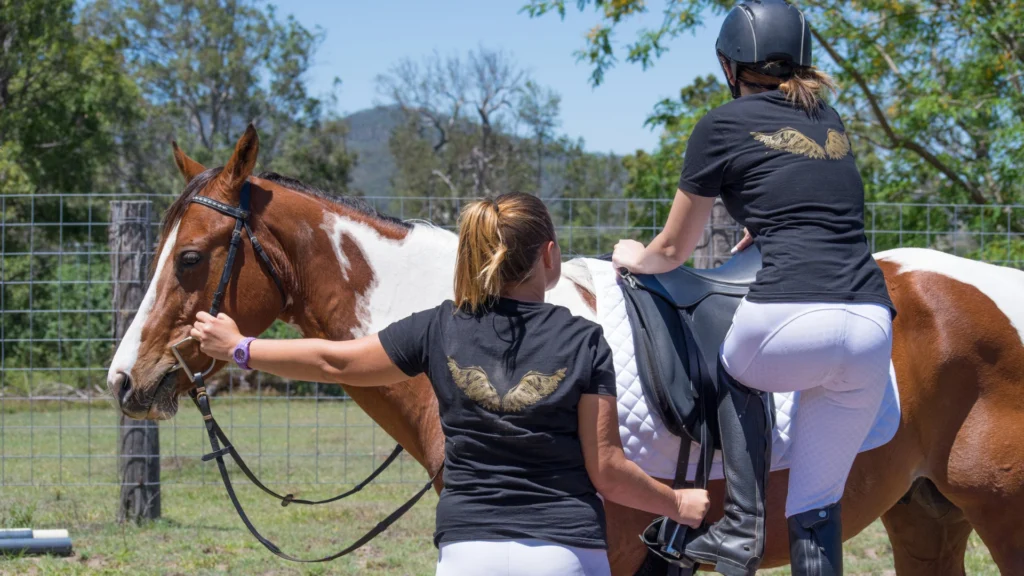
Behavior While Riding: On the Saddle Rules Every Equestrian Should Follow
In the world of horse riding, being in the saddle isn’t just about steering your horse—it’s about riding with mindfulness, responsibility, and respect for everyone in the ring or on the trail. While your horse may follow your physical cues, your behavior plays a big role in ensuring a safe and enjoyable experience for all.
Once you’re on horseback, you’re not only responsible for your ride—you’re also part of a larger, often shared, environment. This could be a bustling training arena, a peaceful trail, or even a competitive showground. Regardless of where you ride, certain behaviors are expected to maintain harmony among horses and riders.
Let’s explore the on-the-saddle rules that define good behavior during horse riding, helping you stay safe, considerate, and in control.
Do: Keep a Safe Distance—One Horse Length is the Rule
One of the golden rules of horse riding is to maintain enough space between yourself and other riders. The general guideline is to keep at least one horse length (roughly 8 to 10 feet) between horses at all times.
Why this matters:
Horses are herd animals, but they still need personal space, especially in unfamiliar environments. Getting too close to another horse can cause anxiety, defensive behavior, or even a dangerous kick.
Best practices to follow:
- Keep a horse-length distance at walk, trot, and canter.
- Increase the gap if your horse or another horse seems nervous.
- Stay alert to any rider signaling that their horse may be unpredictable.
- Creating this buffer zone improves safety and helps every rider maintain better control.
Don’t: Yell, Speed Past, or Tailgate Other Horses
Poor communication and careless movement can disrupt the rhythm of the entire group, and worse, create accidents. Loud noises or sudden actions while horse riding can startle not just your mount but those around you.
Avoid these behaviors while riding:
- Yelling across the arena or trail: Loud voices can spook horses and distract other riders. If you need to speak, do so calmly and clearly.
- Speeding past another rider: Racing past someone at a fast pace without warning can alarm their horse. Always call out and pass slowly, preferably on the outside.
- Tailgating another horse: Riding too close behind another horse is not just rude—it’s dangerous. You risk being kicked or causing a collision.
A better approach:
- Announce your intention to pass with a simple “Passing on your left.”
- Pass at a steady, moderate pace and give ample space while doing so.
- Stay composed and quiet, especially in shared spaces.
- Maintain Control: Ride with Confidence, Not Aggression
One of the key elements of horse riding etiquette is maintaining steady control of your horse. A well-controlled horse responds to soft cues, remains aware of its surroundings, and follows the rider’s lead calmly.
Tips for staying in control:
- Keep both hands on the reins and heels softly in contact with the horse’s sides.
- Use subtle aids rather than aggressive commands.
- Stay focused on your path, pace, and posture.
- If your horse becomes distracted, tense, or overly excited, gently redirect its focus instead of trying to force obedience. A calm rider inspires a calm horse.
Important reminder:
- Riding isn’t about dominating the horse—it’s about communication and balance. A respectful approach builds trust and creates a more relaxed ride for both you and your horse.
- Stay Alert and Aware of Your Surroundings
- Being present in the saddle means more than just staying upright. It requires full awareness of your environment, including other horses, riders, terrain changes, and unexpected obstacles.
Why situational awareness matters:
- In group settings, it helps prevent sudden collisions.
- On trails, it protects you from uneven ground, wildlife, or other riders’ actions.
- In lessons or shows, it allows you to follow instructions smoothly and avoid causing disruptions.
What to watch for while riding:
- Sudden stops or turns by nearby horses.
- Riders preparing to jump, change gait, or pass.
- Loose horses, animals, or people entering the area.
Pro tip:
Periodically glance around to check your surroundings, but always keep most of your focus ahead of your horse.
Bonus Tip: Ride with Empathy
Great riders don’t just ride well—they ride with empathy. While rules and technique matter, treating your horse and fellow riders with kindness and patience makes the experience truly rewarding.
Horse riding is a partnership. Your behavior should always reflect the values of trust, respect, and calm leadership.
Empathetic behavior includes:
- Giving space to a nervous rider or horse.
- Offering help if someone struggles to control their mount.
- Avoiding judgment of less experienced riders—everyone was a beginner once.
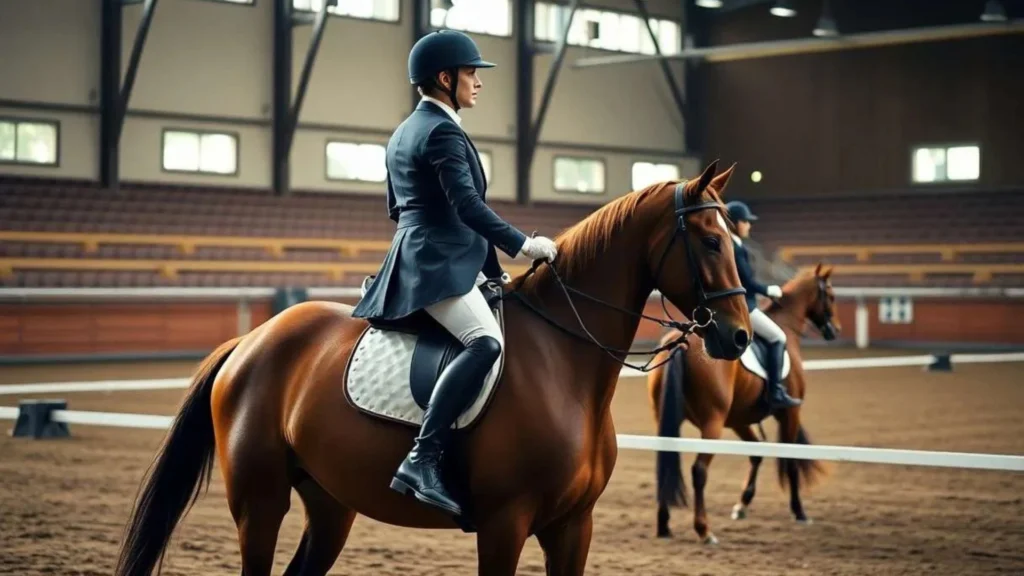
Arena Etiquette and Group Riding: Sharing the Saddle Space with Respect
When it comes to horse riding, much of your experience depends not only on how well you ride, but also on how well you interact with others in the ring. Riding in a group—whether during a lesson, practice session, or free ride—requires a set of unspoken (and sometimes spoken) rules known as arena etiquette.
The riding arena is a shared space, much like a roadway. And just like driving, riding alongside others safely means following a few essential traffic rules. These guidelines help maintain order, prevent accidents, and make group riding smooth and stress-free for both horses and humans.
In this article, we’ll explore the key principles of horse riding etiquette in the arena, including standard traffic patterns, safety rules, and common dos and don’ts.
Do: Pass Left Shoulder to Left Shoulder in the Arena
One of the most important rules in group horse riding is the concept of left-to-left passing. It’s the equestrian equivalent of staying in your lane—and it keeps traffic flowing.
What does “left shoulder to left shoulder” mean?
It means that when two riders are going in opposite directions in the arena, they should pass each other on the left, keeping their left shoulders closest. This rule helps prevent confusion and ensures that both riders are expecting the same movement.
Why it matters:
- Prevents head-on collisions
- Maintains a predictable flow of movement
- Creates a rhythm that all riders can adjust to, especially during busy sessions
- This rule is especially vital in indoor arenas or during lessons where space is limited and multiple horses are moving in various directions.
Don’t: Cut Off Other Riders or Block Gates
Being unaware of your surroundings—or ignoring others in the arena—can cause major disruptions or even accidents.
Common mistakes to avoid:
- Cutting across a rider’s path during transitions or corners.
- Crossing diagonally without checking if the space is clear
- Stopping in front of gates or blocking entry/exit points with your horse
- Standing still on the track, especially during a lesson or peak hours
Tips for courteous riding:
- Always glance both ways before crossing the arena.
- Give right of way to riders who are cantering or jumping.
- Never stop on the rail—move into the center if you need to halt or adjust tack.
- Leave access to gates and doors clear at all times.
- Respecting these boundaries makes the arena a safer, more functional space for everyone involved in horse riding.
- Understand the Riding Order and Ring Flow
- Just like a highway, the riding arena has a natural flow, and it’s not random. Riders moving at different gaits (walk, trot, canter) should follow an unspoken order to prevent congestion and miscommunication.
Standard ring traffic flow in group riding:
- Faster riders stay to the outside (the rail)
- Slower riders or those walking stay on the inside track
- Riders working on specific patterns (circles, lateral work) should be aware of others and avoid interrupting the main track.
- Jumpers or riders using poles should be given the right of way, especially when approaching fences.
Additional guidelines:
- Always ride in the same direction unless instructed otherwise.
- If changing directions, do so at designated times or corners, and announce your intentions when necessary.
- Don’t loiter near corners—horses often need extra room to turn, especially at higher gaits.
- Following the natural riding order keeps everyone moving in harmony, and it builds rhythm in your horse riding sessions.
Stay Aware and Communicate Clearly
A key part of arena etiquette is awareness of your horse, your surroundings, and fellow riders. Horses can become easily distracted or nervous, so the more alert and predictable you are, the more confident your horse will feel.
Stay tuned in by:
- Frequently scanning your environment without losing focus on your horse.
- Listening for instructors’ cues, especially during group lessons
- Calling out your intentions when needed (e.g., “Inside!” or “Crossing!”)
- In group horse riding, silence is not always golden. While yelling should be avoided, polite verbal communication is helpful in tight spaces. It prevents surprises and keeps everyone informed.
- Be Mindful of Space and Personal Boundaries
- Just as important as movement is spacing. Horses need their comfort zones, and crowding another rider—even unintentionally—can result in tension, tail swishing, or worse, a kick.
Best practices for spacing:
- Keep at least one horse length between you and the rider ahead.
- Avoid riding too closely beside another horse unless specifically asked to.
- Give nervous or green horses extra room—they may act unpredictably in a group setting.
- Maintaining good spacing isn’t just about avoiding injury—it shows you respect your fellow riders and understand proper horse riding behavior.
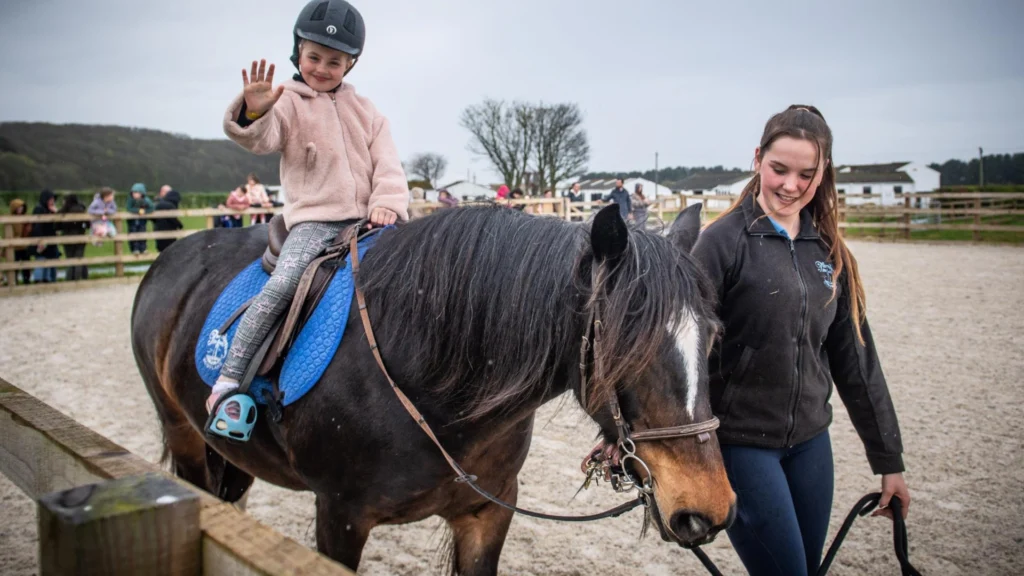
Trail Riding Etiquette: Riding Right in the Great Outdoors
Trail riding is one of the most rewarding aspects of horse riding. It offers scenic views, peaceful surroundings, and a unique opportunity to bond with your horse in nature. But just like arena riding, the trail comes with its own set of rules—known as trail riding etiquette—to ensure the safety, comfort, and enjoyment of everyone involved.
Whether you’re riding with a group or venturing out with a friend, knowing how to conduct yourself on the trail is essential. From how you communicate to how you treat your environment, your behavior impacts not only your ride but also that of others, human and animal alike.
Let’s explore the keydoss and don’ts of trail riding to help you become a more thoughtful, responsible, and prepared rider on every outdoor adventure.
Do: Communicate Clearly with Fellow Riders
One of the most important principles in horse riding—especially on trails—is communication. You may not be in a structured arena, but that doesn’t mean you’re riding alone. A successful trail ride depends on clear, timely, and polite exchanges among riders.
Essential communication practices include:
- Call out trail hazards: If you see a hole, a fallen branch, or a slippery area ahead, alert the riders behind you. A simple “Hole ahead!” or “Low branch!” It can prevent injury.
- Announce turns or changes in pace: Let others know if you’re slowing down, stopping, or turning off the trail. Sudden movements can catch other horses off guard.
- Check in regularly: Especially during longer rides, it’s helpful to ask how others are doing and if anyone needs a break.
- Good communication keeps the group unified and helps maintain calm and cooperation among horses.
Don’t: Leave the Group Without Informing Others
Wandering off or turning back without letting others know isn’t just rude—it can be dangerous. Horses are herd animals. If one horse suddenly leaves the group, it can cause anxiety or unpredictable behavior in the rest of the herd.
Why does this matter in horse riding?
A horse that sees another leave unexpectedly might try to follow, bolt, or become distracted.
Fellow riders may worry that something is wrong or feel pressured to follow without preparation.
You could get lost or injured without backup if no one knows where you’ve gone.
Always inform the lead rider or group before making a change. Even if you’re only pausing to adjust tack or grab water, communication is key to a safe trail experience.
Respect Nature and Non-Riders on the Trail
Trail riding often means sharing the space with hikers, bikers, dogs, and wildlife. As a rider, you represent the entire horse riding community. How you treat others—and the land—reflects on everyone.
Respect for the Environment:
- Stay on marked trails. Straying off the path can damage plants, cause erosion, or disturb wildlife habitats.
- Clean up after yourself and your horse. Don’t leave trash behind, and avoid letting your horse graze in protected areas.
- Minimize noise. Let the natural setting remain peaceful by avoiding shouting, loud music, or disruptive behavior.
Respect for Pedestrians and Cyclists:
- Slow down or halt when passing hikers or bikers. A calm horse reassures nervous pedestrians.
- Say hello and offer instructions if needed. For example: “He’s friendly, but please don’t run past us.”
- Yield when appropriate. Horses generally have the right of way on multi-use trails, but cooperation is always appreciated.
- Being courteous goes a long way in creating positive experiences for everyone and reducing conflicts between different trail users.
Additional Trail Riding Tips for a Safe Ride
- To ensure your horse riding adventure is safe and enjoyable, keep these trail tips in mind:
- Ride single file on narrow trails. This protects the trail and prevents crowding.
- Keep a consistent pace. Sudden speed changes can unsettle other horses.
- Don’t let your horse tailgate. Maintain at least one horse-length of distance.
- Secure all equipment. Loose items can spook horses if they fall or flap in the wind.
- Bring a basic first-aid kit. Be prepared for minor accidents—for both horses and riders.
- Preparedness is a sign of a skilled rider and shows respect for your mount, your group, and the trail itself.
Ride With Empathy and Awareness
Every horse riding experience, especially on the trail, involves more than skill—it requires empathy. You need to read your horse’s behavior, understand your surroundings, and remain aware of how your actions affect others.
Empathy on the trail looks like:
- Slowing down for a nervous rider behind you
- Offering a hand if someone drops a rein or needs to adjust their tack
- Choosing a pace that suits the whole group, not just your horse
- When every rider looks out for the group, the experience becomes more enjoyable, less stressful, and far more memorable.
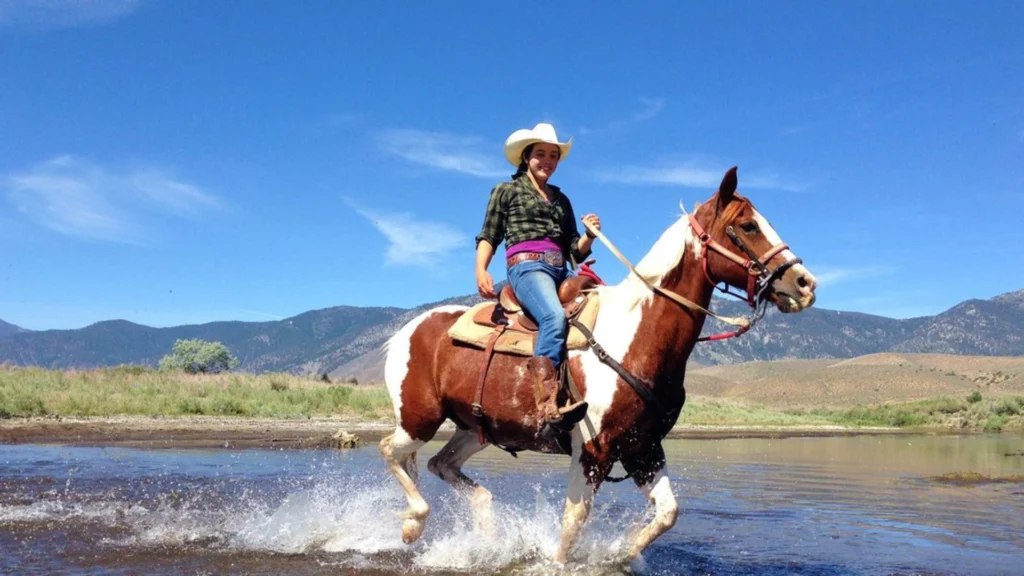
Respect for the Horse: The Heart of Responsible Horse Riding
In the fast-paced world of horse riding, it’s easy to focus on skills, style, and competition. Horse riders often aim for the perfect posture, a smooth canter, or a clean jump. But behind every great rider is a well-treated, willing horse—and that relationship is built on something deeper than technique: respect.
Respecting the horse riding isn’t just good ethics—it’s good horsemanship. From how you communicate in the saddle to how you handle correction, your behavior influences not just performance, but trust. A horse is not a tool or machine; it’s a living, feeling partner. In any discipline of horse riding, the foundation of success is kindness, fairness, and mutual understanding.
Let’s explore what respectful riding looks like, what it doesn’t, and how this mindset leads to a more fulfilling and ethical journey for both horse and rider.
Do: Reward Good Behavior and Be Gentle with Cues
Positive reinforcement is one of the most powerful tools in horse riding. When your horse responds correctly—whether it’s picking up the right lead, stopping on cue, or simply staying calm in a new environment—it deserves acknowledgment.
How to reward your horse riding effectively:
- Use voice and tone: A soft “Good boy” or “Well done” can mean a lot to a horse used to your voice.
- Offer a pat or scratch: Horses enjoy gentle touch, especially on the withers or neck.
- Release pressure promptly: The moment your horse does what you asked, soften the reins or legs. This teaches the horse that they responded correctly.
- Gentle cues also go a long way. Horse riding should be a conversation, not a battle. Clear, soft, and well-timed aids (like light rein contact or a nudge from the leg) show finesse and build responsiveness.
Tip: Riders who rely on gentleness usually build horses that are more confident, relaxed, and eager to please.
Don’t: Overuse the Whip or Harsh Aids
There’s a dangerous misconception that dominance leads to obedience. While assertiveness has a place in horse riding, cruelty never does. Horses learn best from consistency and compassion, not fear.
Common misuses to avoid:
- Repeated whip use: A crop should reinforce an aid, not punish the horse. Overuse can lead to resentment or fear.
- Yanking on the reins: This can hurt the horse’s sensitive mouth and lead to head tossing, tension, or refusal to work.
- Digging in the spurs: Spurs should only be used by advanced riders and never to cause pain.
- Losing patience: Slapping, yelling, or aggressive corrections may work temporarily, but they damage the relationship and make riding a struggle, not a partnership.
- Remember: the goal of horse riding is communication, not control. A horse riding forced into obedience isn’t truly cooperating—it’s reacting.
Bonding Builds Trust, Not Just Technique
The best riders know their horses—not just how they move, but who they are. Taking time to bond creates a foundation for everything you do together.
Ways to bond with your horse:
- Groom without rushing. Make it a calming, interactive moment, not just preparation for riding.
- Spend time on the ground. Practice leading, groundwork, or simply hang out with your horse, riding in the pasture or stall.
- Learn your horse’s signals. Tail swishing, ear movement, licking, and chewing all reveal how your horse feels.
- In horse riding, a bonded rider and horse communicate more intuitively. The horse riding becomes more responsive, the rider more aware, and the ride more fluid.
Fair Treatment Builds a Willing Partner
Every horse deserves fairness, understanding, patience, and consistency in every interaction. Horses don’t misbehave out of malice; they respond to discomfort, confusion, or fear.
Fair treatment includes:
- Understanding limitations. Not every horse can jump four feet or do flying changes. Know your horse’s physical and mental limits.
- Being consistent with cues. Mixed signals frustrate horses. Use the same aids and expectations for every ride.
- Forgiving mistakes. Horses have off days, too. Sometimes they’ll spook, refuse, or act out. That’s normal, and how you respond defines your character as a rider.
- A horse that trusts its rider is far more likely to perform well, stay sound longer, and enjoy their work. Fairness in horse riding is not optional—it’s essential.
Listen to What the Horse Is Saying
Respect isn’t just about action—it’s also about listening. Horses speak through body language. As riders, we must stay attuned to signs of discomfort, fear, or fatigue.
Watch for these signals:
- Pinned ears or tail swishing: Could indicate pain or irritation.
- Resistance to move forward: May be due to confusion, soreness, or stress.
- Head tossing or mouth grinding: Often signs of discomfort in the bit or frustration with rein pressure.
- If your horse is “acting out,” don’t jump to discipline—investigate the cause. Your willingness to listen will deepen your bond and improve your overall horse riding experience.
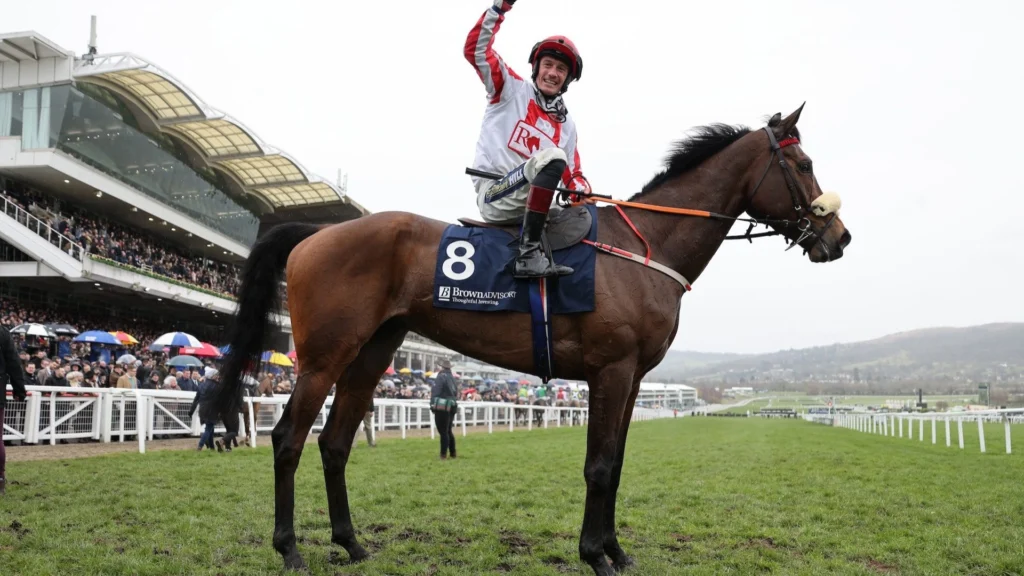
Post-Ride Protocol: The Unsung Art of Ending Your Horse Riding Session Right
Most riders are taught how to saddle up, steer through transitions, and perfect their seat in the saddle. But what often gets overlooked in horse riding education is how to end a ride the right way. Post-ride protocol is more than a checklist—it’s a critical aspect of horsemanship that reflects your care, discipline, and respect for your horse and the riding environment.
After your session ends, your horse doesn’t clock out. Its muscles are still cooling, its tack is still strapped on, and the barn staff might be preparing for the next rider. Whether you’re in a lesson or out on a trail, what you do after dismounting can greatly affect your horse’s health, your gear’s longevity, and your reputation as a responsible rider.
Here’s a detailed breakdown of what to do and what to avoid after every horse riding session.
Do: Dismount Calmly and Thoughtfully
The dismount isn’t just a formality—it’s the start of your horse’s recovery. Rushing off or slumping to the ground can confuse or stress the horse, especially after an intense session.
Proper dismount technique:
- Come to a full stop and take a deep breath—relaxation is contagious.
- Remove your feet from the stirrups.
- Gently swing your right leg over the horse’s back without brushing against its rump.
- Land with knees bent and reins gathered, keeping light contact in case your horse shifts.
- A smooth dismount tells your horse, “You’re safe, the work is over, and I’m still here.”
Do: Give Your Horse a Proper Cooldown
Just like human athletes, horses need to cool down gradually after physical exertion. Abruptly ending a ride can leave muscles tight and overworked, potentially leading to injury or discomfort.
Post-ride cooling methods in horse riding:
Walk your horse for 5 to 10 minutes, either in-hand or under saddle, depending on the ride’s intensity.
- Allow the heart rate and breathing to normalize before removing the tack.
- Use a sweat scraper to wick off moisture after rinsing the horse, especially in warm weather.
- In winter, consider using a cooler rug to help your horse dry without catching a chill.
- This is also a great time to connect—talk softly, stroke your horse’s neck, and appreciate the ride you shared.
Do: Clean and Care for Your Tack Immediately
Neglecting your tack after a ride doesn’t just reduce its lifespan—it could result in safety hazards the next time you mount up. Dirt, sweat, and grime wear down leather and stitching quickly.
Good tack maintenance practices:
- Wipe down your bridle, bit, and saddle with a damp cloth or sponge.
- Hang reins and bridles properly—don’t leave them twisted or lying on the floor.
- Inspect all buckles and straps for wear or damage.
- Air out saddle pads and girths so they dry completely before next use.
- Every seasoned rider knows: well-maintained tack = safer horse riding.
Don’t: Leave Your Horse Sweaty, Soiled, or Sore
The end of a ride is your chance to care for your horse’s comfort and hygiene. A horse left sweaty or improperly groomed is at risk for saddle sores, fungal infections, and behavioral issues in the future.
Common grooming steps after riding:
- Use a soft brush to remove sweat marks, especially under the girth and saddle areas.
- Pick out hooves—tiny stones and mud clumps can cause irritation or lameness.
- Check for swelling, heat, or tender spots, particularly in the legs, back, and under the tail.
- Use fly spray or apply liniment as needed.
- A clean, comfortable horse is more likely to look forward to your next horse riding session.
Don’t: Leave a Mess Behind in the Barn or Arena
Nothing breaks barn harmony faster than a rider who walks away without cleaning up. In any shared horse riding facility, leaving behind hair clumps, grooming tools, or tack is disrespectful and inconsiderate.
Post-ride area etiquette:
- Sweep up loose hair, hay, or hoof debris.
- Return brushes, flies, and hoof picks to their rightful spots.
- Don’t leave tack drying in common walkways or entry points.
- Dump and rinse water buckets or treat bowls if you’ve used them.
- A tidy barn is a happy barn. And it only takes five minutes to leave things better than you found them.
Do: Say Thank You to the People Behind the Scenes
Instructors, grooms, and barn managers—these individuals are often the unsung heroes of your horse riding experience. Whether they taught your lesson, prepped your horse, or mucked the stall while you rode, acknowledging their effort fosters a positive and professional riding environment.
Small gestures of appreciation include:
- A verbal “Thank you, that was a great lesson” to your trainer.
- Helping untack or wipe down a school horse for the barn staff.
- Saying goodbye when you leave—it shows respect for everyone’s time and space.
- Kindness is free, and it keeps your name associated with good manners and gratitude in the horse riding community.
Bonus Tip: Reflect and Record
While your horse is munching on hay post-ride, take a few moments to reflect on how the ride went. Good riders grow from self-awareness, not just saddle time.
What to jot down in a riding journal:
- How your horse behaved today
- What exercises worked well
- Any challenges you faced
- Goals for your next ride
This habit sharpens your focus and helps you progress more effectively in your horse riding journey.
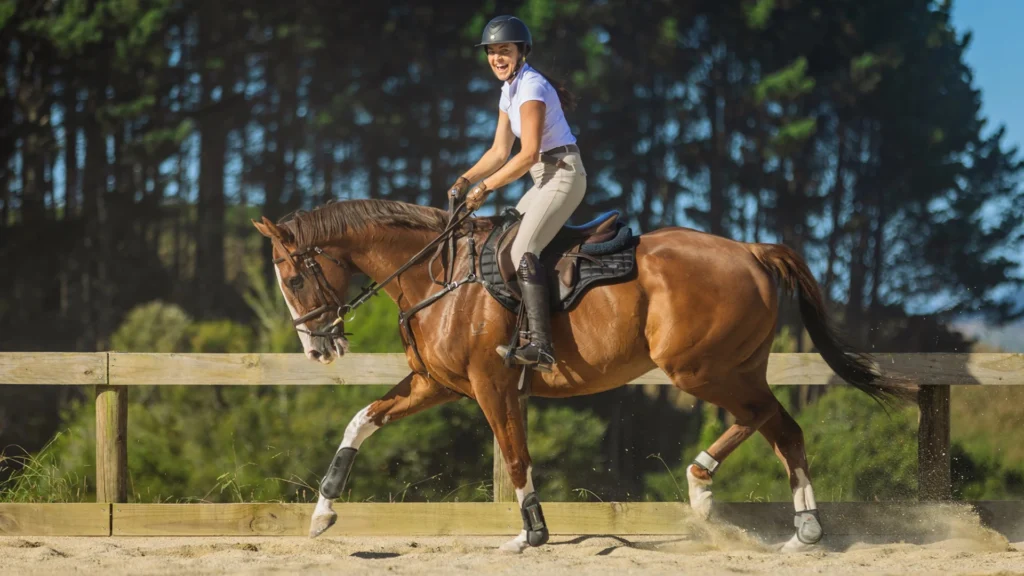
Common Beginner Mistakes to Avoid in Horse Riding
Embarking on your horse riding journey is thrilling, feeling the power of a horse beneath you, learning to communicate without words, and building confidence in the saddle. However, like with any new skill, beginners are bound to make a few missteps. The key is to learn from them and avoid habits that could put you—or your horse—at risk.
Whether you’re riding at a stable, taking lessons, or heading out on trails, understanding the most common beginner mistakes can fast-track your progress and help you become a safer, more responsible rider.
Here’s a breakdown of critical errors to watch out for—and how to correct them early on in your horse riding journey.
1. Miscommunication with the Horse
One of the biggest challenges for beginners is learning how to communicate effectively with their horse. Horses respond to body language, tone, and subtle cues—not loud voices or forceful movements. When beginners give mixed signals or unintentionally confuse the horse, it can lead to resistance, frustration, or even unsafe situations.
Common communication mistakes:
- Using inconsistent leg or rein aids
- Holding tension in the body, which transmits nervous energy.
- Pulling too hard on the reins or failing to release pressure after a cue
- Speaking loudly or making abrupt movements
What to do instead:
- Use clear, consistent cues and release pressure as soon as the horse responds.
- Keep your posture balanced and relaxed—horses mirror the rider’s energy.
- Learn basic equine body language to understand what your horse is telling you.
- Effective communication is the heart of horse riding—without it, there’s no true partnership.
2. Ignoring the Posted Arena or Trail Rules
Whether you’re riding in a structured arena or out on a scenic trail, there are usually rules in place to ensure safety and harmony. Beginners sometimes skip reading signs or forget verbal instructions, leading to misunderstandings or unsafe behavior.
Examples of overlooked rules:
- Failing to pass left shoulder to left shoulder in the arena
- Not yielding to faster riders or those jumping
- Galloping in restricted areas or weaving through crowded trails
- Blocking arena gates or stopping on the main riding track
How to fix it:
- Always check posted signs before riding and ask your instructor if you’re unsure.
- Observe how more experienced riders behave in shared spaces.
- Be courteous—safety in horse riding is everyone’s responsibility.
- Respecting rules isn’t about limiting your freedom—it’s about keeping everyone safe, including your horse.
3. Not Checking Girth or Tack Before Mounting
This mistake is more common than you’d think—and it can have serious consequences. An improperly fastened girth or loose saddle can cause the tack to slip, leading to falls, discomfort for the horse, and damaged equipment.
Common oversights:
- Forgetting to tighten the girth after the horse has relaxed (often called “girthy” behavior)
- Not checking that the saddle is centered or secure
- Failing to inspect stirrup leathers, bridles, or buckles before mounting
- Assuming the barn staff checked everything for you
Best practices:
- Always check and re-check the girth before getting on, especially if the horse puffs up during tacking.
- Perform a tack safety check: saddle, girth, bridle, stirrups, and bit placement.
- If anything feels off, once you mount, dismount, and adjust. It’s safer and more respectful to your horse.
- In horse riding, taking five extra seconds to double-check tack can prevent injuries and build your horse’s trust.
4. Skipping the Warm-Up or Cooldown
New riders often focus solely on what happens during the lesson or ride itself, ignoring the importance of warming up or cooling down the horse. But horses, like humans, need time to prepare their bodies and recover after work.
Why it matters:
- Warming up helps loosen muscles and prevent injury.
- Cooling down gradually lowers the horse’s heart rate and helps prevent stiffness.
- Skipping either can result in soreness, discomfort, or behavioral issues in future rides.
What to do:
- Start each ride with 5–10 minutes of walking and light trotting.
- End your ride with a similar cooldown period—either in the saddle or by hand.
- Use this time to build rapport with your horse and reflect on your session.
- Proper warm-up and cooldown are essential habits in responsible horse riding.
5. Forgetting to Listen and Learn
In the excitement of riding, beginners sometimes forget that horse riding is a continuous learning process. Whether it’s tuning out your instructor, rushing ahead of your skill level, or comparing yourself to others, ignoring guidance can hold you back.
Avoid these traps:
- Trying to canter before mastering the trot
- Getting frustrated when your horse doesn’t respond perfectly
- Overlooking feedback from your coach or peers
- Riding without understanding your horse’s mood or body language
Better approach:
- Be patient. Progress in horse riding is gradual, and every ride teaches you something.
- Stay humble. There’s always more to learn—even Olympic riders take lessons.
- Treat mistakes as part of the process, not failures.
The best riders are the best students—open to feedback and eager to improve.
Ride with Grace and Gratitude: An Enduring Lesson in Equestrian Etiquette
Every step, every gesture, and every quiet moment between horse and rider hides an opportunity—not just to ride well, but to ride graciously. As we conclude our journey through equestrian etiquette, it’s important to remember that good manners in the saddle aren’t just rules—they’re a reflection of character.
From the first time you approach a horse to hee final brushstroke after a lesson, how you present yourself shapes your experience and your bond with your equine companion. Etiquette isn’t about perfection; it’s about awareness, compassion, and respect—the true traits of a devoted horseman.
Let’s consider what it means to ride with grace and how gratitude can elevate every part of your equestrian journey.
What gracefulness looks like in the saddle
Gracefulness isn’t just about riding posture or style—it’s about emotional balance, patience, and the ability to calmly adapt to any situation. A graceful rider is calm, respectful, and mindful of their horse and those around them.
- In terms of equestrian etiquette, gracefulness can be seen in small actions:
- Giving space to other riders in the arena.
- Communicating gently with your horse, even when they’re distracted or stubborn.
- Accepting corrections from the instructor without a defensive attitude.
- Waiting your turn with quiet confidence on the trail or during a group ride.
- Graceful riding builds confidence, reduces stress, and sets a positive example for fellow riders.
The Power of Gratitude in Horsemanship
Too often, riders focus only on performance—how high they jumped, how smooth their canter was, or whether they placed in a show. But behind every moment of success is a living, breathing animal who gave you their trust, and a team of people who made that moment possible.
Gratitude in horseback riding means:
- Saying “thank you” to your instructor, barn manager, and fellow riders.
- Patting your horse after a ride, saying a kind word, or spending a few extra minutes grooming him.
- Taking the time to clean up your belongings and tidy up your area, even when no one is looking.
- Recognizing how lucky we are to get to spend time with such great animals.
- Gratitude turns every ride into a gift, not a right. It turns obligation into pleasure and exercise into a privilege.
Recapping the Essential Elements of Horsemanship Etiquette
Let’s revisit the fundamental etiquette practices that define a respectful rider:
- Approach with calm: Always greet your horse and others with calm energy – never rushing or startling.
- Climb and ride carefully: Use proper climbing techniques, maintain awareness of others in shared spaces, and ride with attention and intention.
- Maintain a safe distance: In both the arena and trails, always leave space between horses to avoid accidents.
- Follow barn and trail rules: Respect posted guidelines, traffic patterns, and the rights of other trail users.
- Care for your horse after a ride: Cool your horse down, groom properly, and check for any signs of discomfort.
- Clean your gear and space: Keep your tack in good condition and leave the barn cleaner than you found it.
- Be humble and willing to learn: Accept advice, admit your mistakes, and commit to growing as a rider.
- Each of these practices isn’t just about good manners—they’re about making the world of horseback riding safer, kinder, and more enjoyable for everyone.
Lead by example: Courtesy is contagious.s
The smallest gesture of kindness can spread outward. When other riders see you pick up dropped brush, thank your instructor, or check on someone struggling, they’re encouraged to do the same. This is how barn culture improves—through shared values and everyday thoughtful actions.
Whether you’re a beginner or an experienced rider, your attitude matters. A kind word, a respectful gesture, or a thoughtful reminder to a fellow rider can make a huge difference.
Grace and gratitude aren’t just accessories in horseback riding—they’re essentials.
What’s your conclusion? Let’s hear from you!
As we conclude this journey through horseback riding etiquette, take a moment to reflect on your own experience. Perhaps one of these tips surprised you, reminded you of something you forgot, or inspired you to be more careful on your next ride.
Which etiquette tip surprised you the most? Share your thoughts or your advice in the comments!
Let’s continue to learn, share, and grow together, one ride at a time.
Read about Sports with Duniya Sports

